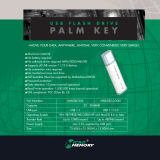
Table of Contents
1. Introduction .......................................................................................................................................... 1
Overview .............................................................................................................................................. 2
ARDC (Automatic Recovery Data Communication) .............................................................................. 2
Package Checklist .................................................................................................................................. 2
Product Features ................................................................................................................................... 3
Product Specifications ............................................................................................................................ 3
LED Indicators ....................................................................................................................................... 5
Adjustable Pull High/Low, Terminator Resistors for the RS-485 Port ...................................................... 6
2. Installation and Configuration .............................................................................................................. 1
Initial Driver Installation ......................................................................................................................... 2
Hardware Installation ...................................................................................................................... 4
Windows 98/ME and Windows 2000 .................................................................................................. 4
Windows XP, Windows 2003/Vista, and Windows 2008 and 2012 (32-bit and 64-bit) .............................. 5
Configuring the COM Port .............................................................................................................. 10
Configuring the Converter ............................................................................................................. 11
Removing the Converter ............................................................................................................... 13
Uninstalling the Driver .................................................................................................................. 14
Advanced UPort 1100 Driver Functions ................................................................................................... 15
Enable Fixed-base COM Mode ................................................................................................................ 15
Install Linux Driver .............................................................................................................................. 16
Linux Kernel 2.4.20 and above ....................................................................................................... 16
Linux Kernel 2.6.x ........................................................................................................................ 17
Installing the Windows CE Driver ........................................................................................................... 19
Installation with an installation package for Win CE 6.0 ..................................................................... 20
Installation with an installation package for Win CE 5.0 ..................................................................... 27
Removing the Moxa WinCE 5.0 / CE 6.0 Driver................................................................................. 29
Installation with a CAB File ............................................................................................................ 30
Removing the Moxa WinCE 5.0 / CE 6.0 Driver................................................................................. 32
3. Pin Assignment ..................................................................................................................................... 1
UPort DB9 Pin Assignments ..................................................................................................................... 1
Terminal Block Pin Assignments .............................................................................................................. 1
A. EMI Notices ........................................................................................................................................... 1
EMI Notices (Class B) ............................................................................................................................. 1
GREEN Notices ...................................................................................................................................... 1
























